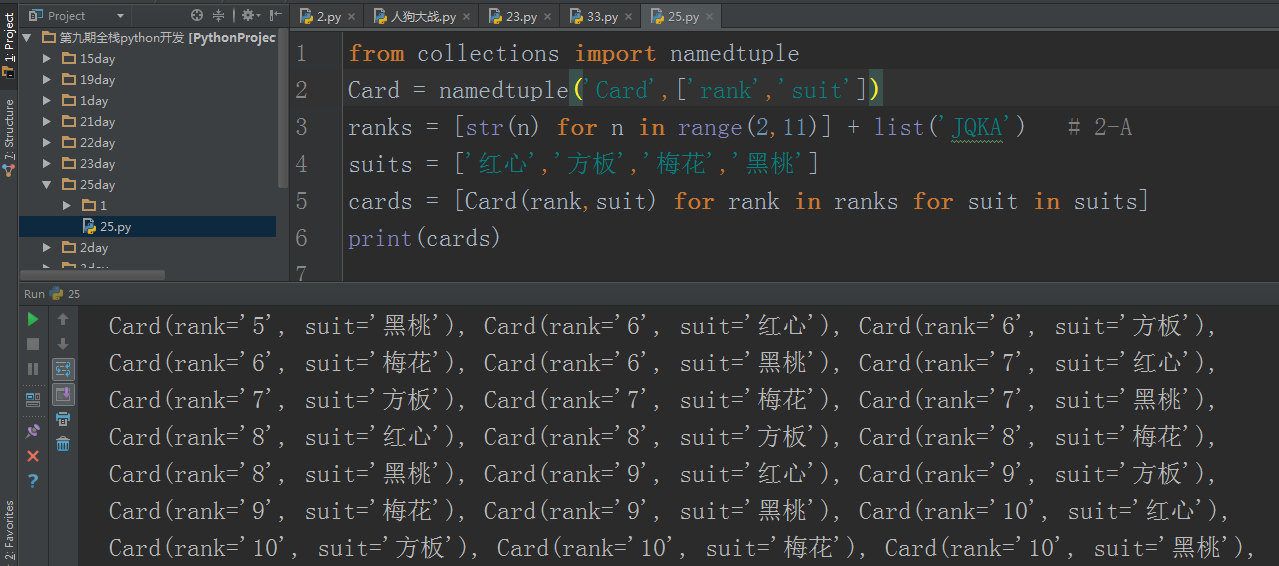面向对象进阶-item系列、__new__、__hash__、__eq__ (四)
item系列
dic = {'k':'v'}
# 对象 : 存储属性 和调用方法
dic['k'] = 'v'
# class Foo:
# def __init__(self,name,age,sex):
# self.name = name
# self.age = age
# self.sex = sex
#
# def __getitem__(self, item):
# if hasattr(self,item):
# return self.__dict__[item]
#
# def __setitem__(self, key, value):
# self.__dict__[key] = value
#
# def __delitem__(self, key):
# del self.__dict__[key]
#
# f = Foo('egon',38,'男')
# print(f['name'])
# f['hobby'] = '男'
# print(f.hobby,f['hobby'])
# del f.hobby # object 原生支持 __delattr__
# del f['hobby'] # 通过自己实现的
# print(f.__dict__)
__new__
# __init__ 初始化方法
# __new__ 构造方法 : 创建一个对象
class A:
def __init__(self):
self.x = 1
print('in init function')
# def __new__(cls, *args, **kwargs): 为什么这里是cls而不是self,因为先执行_new_才有self
# print('in new function')
# return object.__new__(A, *args, **kwargs) 执行object后才产生类A
a =A()
print(a)》》》显示 :'in new function' 'in init function'
# a1 = A()
# a2 = A()
# a3 = A()
# print(a1)
# print(a2) a1/a2/a3打印出的内存地址不一样,多个类对象的内存空间
# print(a3)
# print(a.x)
# 设计模式
# 23种
# 单例模式
# 一个类 始终 只有 一个 实例
# 当你第一次实例化这个类的时候 就创建一个实例化的对象
# 当你之后再来实例化的时候 就用之前创建的对象
# class A:
# __instance = False
# def __init__(self,name,age):
# self.name = name
# self.age = age
# def __new__(cls, *args, **kwargs):
# if cls.__instance: 第二次为真,执行这里
# return cls.__instance
# cls.__instance = object.__new__(cls) cls可不填 第一次__instance为假执行这里,创建对象赋值给cls.__instance
# return cls.__instance
#
# egon = A('egg',38)
# egon.cloth = '小花袄'
# nezha = A('nazha',25)
# print(nezha) 》内存地址一样
# print(egon) 》》内存地址一样
# print(nezha.name) 》nazha
# print(egon.name) 》》nazha
# print(nezha.cloth) 》》'小花袄'
__eq__
# class A:
# def __init__(self,name):
# self.name = name
#
# def __eq__(self, other): eq方法
# if self.__dict__ == other.__dict__:
# return True
# else:
# return False
#
# ob1 = A('egon')
# ob2 = A('egg')
# print(ob1 == ob2) 》》False 没有__eq__时默认比较内存地址,等于不成立false
__hash__哈希
# hash() 哈希值,不同对象,哈希值不同
# class A:
# def __init__(self,name,sex):
# self.name = name
# self.sex = sex
# def __hash__(self): 哈希值是否相等由自定义hash来控制,不走内置hash()
# return hash(self.name+self.sex)
#
# a = A('egon','男')
# b = A('egon','nv')
# c = A('egon','nv')
# print(hash(a))
# print(hash(b))
# print(hash(c)) b和c哈希值一样
import json
from collections import namedtuple
Card = namedtuple('Card',['rank','suit']) # rank 牌面的大小 suit牌面的花色(这个相当于一个只有属性的类)
C1=Card(2,"红心")》print(C1)》Card(rank=2,suit="红心")(实例化)
# class FranchDeck:
# ranks = [str(n) for n in range(2,11)] + list('JQKA') # 2-A
# suits = ['红心','方板','梅花','黑桃']
#
# def __init__(self):
# self._cards = [Card(rank,suit) for rank in FranchDeck.ranks
# for suit in FranchDeck.suits]
解释》》for suit in FranchDeck.suits
for rank in FranchDeck.rangks 》》》
Card(suit,rank) 《《

#
# def __len__(self):
# return len(self._cards)
#
# def __getitem__(self, item):
# return self._cards[item]
#
# def __setitem__(self, key, value):
# self._cards[key] = value
#
# def __str__(self):
# return json.dumps(self._cards,ensure_ascii=False)
# deck = FranchDeck()
# print(deck[10])
# from random import choice
# print(choice(deck)) choice依赖_len_方法
# # print(choice(deck))
# from random import shuffle
# shuffle(deck) shuffle依赖setitem方法
# print(deck[10])
# print(deck)
# print(deck[:5]) #切片,利用items系列
# 内置函数 内置的模块 内置的基础类型 < --- >类的内置方法
# == 》》内置调用 __eq__
# len() 》》内置调用__len__
# 100 名字 和 性别 年龄不同
# set 集合,可以去重
# class A:
# def __init__(self,name,sex,age):
# self.name = name
# self.sex = sex
# self.age = age
#
# # def __eq__(self, other):
# # if self.name == other.name and self.sex == other.sex:
# # return True
# # return False
#
# def __hash__(self):
# return hash(self.name + self.sex)
# a = A('egg','男',38)
# b = A('egg','男',37)
# print(set((a,b))) # unhashable(是不可哈希意思)
# set 依赖对象的 hash eq



